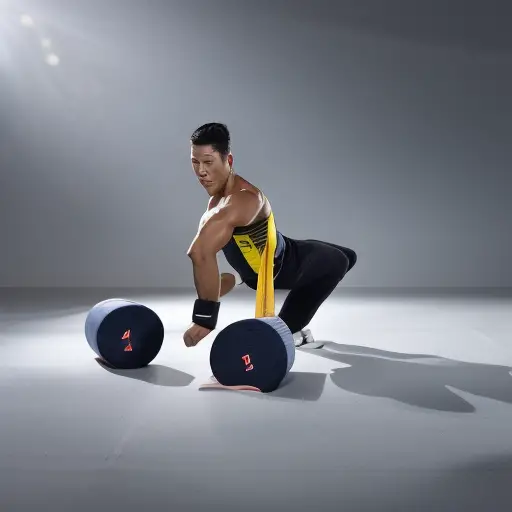Injury Prevention and Recovery in Taekwondo

In the world of taekwondo, athletes constantly push their bodies to the limit, seeking physical and mental mastery. However, this pursuit of excellence also comes with the risk of injuries that can hinder progress and dampen spirits.
To combat this, a comprehensive approach to injury prevention and recovery is essential. This article delves into the common injuries in taekwondo, offers evidence-based warm-up and stretching techniques, suggests strength and conditioning exercises, and provides practical strategies for recovery and returning to training after an injury.
Common Injuries in Taekwondo
The article will now delve into the common injuries in Taekwondo. Taekwondo is a dynamic martial art that involves high kicks, strong punches, and rapid movements, making it susceptible to certain types of injuries. Understanding these common injuries can help practitioners take preventive measures and utilize effective rehabilitation techniques.
One of the most prevalent injuries in Taekwondo is sprained ankles. Due to the constant pivoting and twisting motions, the ligaments in the ankle can become strained or torn. To prevent ankle sprains, practitioners should wear supportive footwear and perform regular ankle strengthening exercises. In cases of injury, the RICE (Rest, Ice, Compression, Elevation) method is recommended, followed by a gradual return to training under the guidance of a qualified sports therapist.
Another common injury is knee pain, often caused by repetitive kicks and jumps. Strengthening the quadriceps and hamstrings through targeted exercises can help prevent knee injuries. In cases of knee pain, rest and ice application are recommended, followed by a gradual return to training with modified techniques.
Warm-up and Stretching Techniques
Effective warm-up and stretching techniques are essential in preparing the body for the physical demands of Taekwondo training and reducing the risk of injury. To optimize performance and minimize the chance of injury, Taekwondo athletes should incorporate the following techniques into their warm-up routine:
-
Dynamic stretching: Dynamic stretching involves moving the muscles and joints through a full range of motion. This type of stretching helps increase flexibility, improve coordination, and enhance muscular performance. Examples of dynamic stretches for Taekwondo include leg swings, arm circles, and trunk rotations.
-
Foam rolling techniques: Foam rolling is a form of self-massage that uses a foam roller to release tension and tightness in muscles and fascia. By applying pressure to specific areas of the body, foam rolling can improve circulation, increase range of motion, and reduce muscle soreness. Taekwondo practitioners can use a foam roller to target areas such as the calves, quads, and glutes.
-
Active warm-up exercises: Engaging in light aerobic activities, such as jogging or jumping jacks, can increase heart rate and body temperature, promoting blood flow to the muscles. This type of warm-up also helps activate the neuromuscular system, preparing the body for the dynamic movements involved in Taekwondo.
-
Sport-specific movements: Incorporating sport-specific movements into the warm-up routine can help athletes mentally and physically prepare for their Taekwondo training. These movements can include shadowboxing, kicking drills, or practicing basic forms and techniques.
By implementing these warm-up and stretching techniques, Taekwondo practitioners can improve their performance and reduce the risk of injury. These techniques not only enhance flexibility and mobility but also help increase blood flow, improve coordination, and activate the muscles and joints.
Transitioning into the subsequent section about ‘strength and conditioning exercises for injury prevention’, it is important to maintain a comprehensive training program that includes both warm-up and strength exercises for optimal injury prevention and recovery.
Strength and Conditioning Exercises for Injury Prevention
Implementing proper strength and conditioning exercises, along with a well-rounded warm-up routine, is crucial for preventing injuries in Taekwondo athletes.
Strength and conditioning exercises focus on enhancing the physical attributes necessary for optimal performance in Taekwondo, such as power, speed, agility, and balance. These exercises should involve functional movements that mimic the demands of the sport, helping athletes develop the necessary strength and stability to perform dynamic kicks, strikes, and defensive maneuvers effectively.
Functional movements, such as squats, lunges, and deadlifts, should be incorporated into strength training routines. These exercises target multiple muscle groups simultaneously, improving overall strength and stability. Additionally, plyometric exercises, such as box jumps and depth jumps, can enhance power and explosiveness, which are essential for executing swift and forceful movements in Taekwondo.
It is important to note that strength and conditioning programs should be tailored to individual athletes’ needs and skill levels. Athletes should focus on proper technique and gradually progress in intensity and volume to avoid overexertion and injury. Seeking guidance from a qualified strength and conditioning specialist can be beneficial in designing an appropriate program that aligns with the unique demands of Taekwondo.
Recovery Strategies for Taekwondo Athletes
To ensure optimal performance and reduce the risk of injuries, taekwondo athletes should prioritize recovery strategies. Recovery is an essential component of any training program as it allows the body to repair and adapt to the physical stress imposed during training and competitions.
Here are four key recovery strategies that taekwondo athletes should consider:
-
Nutrition and Hydration for Recovery: Proper nutrition and hydration are crucial for facilitating recovery. Athletes should consume a balanced diet that includes adequate amounts of carbohydrates, protein, and healthy fats. Carbohydrates replenish glycogen stores, while protein supports muscle repair and growth. Additionally, staying hydrated helps maintain optimal performance and aids in the removal of waste products from the body.
-
Rest and Sleep: Sufficient rest and quality sleep are vital for recovery. During sleep, the body repairs damaged tissues, regulates hormone levels, and restores energy stores. Taekwondo athletes should aim for 7-9 hours of sleep per night and incorporate rest days into their training schedule to allow for proper recovery.
-
Active Recovery: Engaging in low-intensity activities such as light stretching, swimming, or cycling can promote blood flow to the muscles, reduce muscle soreness, and improve overall recovery. Active recovery helps flush out metabolic waste products and enhances the delivery of nutrients to the muscles.
-
Sports Psychology for Injury Rehabilitation: Psychological factors play a significant role in injury rehabilitation. Mental skills training, such as visualization, goal setting, and positive self-talk, can help athletes cope with the physical and emotional challenges of recovering from an injury. Seeking support from sports psychologists or mental health professionals can also be beneficial in the healing process.
Tips for Returning to Training After an Injury
Reintegrating back into training after an injury requires careful planning and a gradual approach. Returning to competition can be both physically and mentally challenging for taekwondo athletes. Therefore, it is important to consider not only the physical aspects of recovery but also the mental preparation needed to regain confidence and perform at the same level as before the injury.
To begin with, it is crucial to consult with a healthcare professional or a sports medicine specialist before returning to training. They can assess the extent of the injury, provide appropriate rehabilitation exercises, and determine when it is safe to resume training. Following their guidance is essential to avoid re-injury and ensure a successful return.
In terms of mental preparation, athletes may experience anxiety or fear of re-injury when returning to training. To address these concerns, it is recommended to work with a sports psychologist or mental skills coach. They can help athletes develop coping strategies, manage stress, and build confidence to perform at their best.
Additionally, gradually increasing the intensity and duration of training sessions can help athletes rebuild their strength and endurance. Starting with low-impact exercises and gradually progressing to more demanding drills can minimize the risk of re-injury and allow the body to adapt to the demands of training.
Frequently Asked Questions
What Are the Most Common Mistakes That Taekwondo Athletes Make During Their Warm-Up and Stretching Routines?
During warm-up and stretching routines, taekwondo athletes commonly make mistakes that can increase their risk of injury. Identifying and avoiding these mistakes is crucial for injury prevention and optimal performance in taekwondo training and competitions.
Are There Any Specific Strength and Conditioning Exercises That Should Be Avoided by Taekwondo Athletes to Prevent Injuries?
Specific exercises to be avoided in taekwondo for injury prevention include excessive plyometrics, heavy weightlifting without proper technique, and high impact exercises on hard surfaces. Alternative methods, equipment recommendations, and common mistakes should be considered for warm-up and stretching routines.
How Long Does It Typically Take for Taekwondo Athletes to Recover From a Sprained Ankle?
On average, taekwondo athletes can expect to recover from a sprained ankle within 4-6 weeks. However, proper warm-up and stretching routines, along with alternative recovery strategies and recommended equipment, can expedite the healing process and prevent re-injury.
Are There Any Alternative Recovery Strategies for Taekwondo Athletes Who Are Unable to Use Ice or Cold Therapy?
Alternative recovery strategies for taekwondo athletes who are unable to use ice or cold therapy include heat therapy, compression techniques, elevation, and non-cold modalities such as ultrasound, laser therapy, and electrical stimulation. These methods can aid in reducing pain, inflammation, and promoting healing.
Is It Recommended to Use Any Specific Equipment or Gear During the Recovery Phase to Prevent Re-Injury?
Using proper recovery gear and equipment during the post-training phase is crucial for preventing re-injury in taekwondo. Additionally, a thorough warm-up routine should be implemented to enhance blood flow, flexibility, and overall readiness for the training session.
Conclusion
In conclusion, injury prevention and recovery are crucial aspects of training in taekwondo.
By understanding the common injuries, implementing proper warm-up and stretching techniques, incorporating strength and conditioning exercises, and utilizing effective recovery strategies, taekwondo athletes can reduce the risk of injuries and enhance their performance.
It is essential for athletes to gradually return to training after an injury, following practical recommendations to ensure a safe and successful comeback.
Remember, taking care of your body is the key to long-term success in taekwondo.





